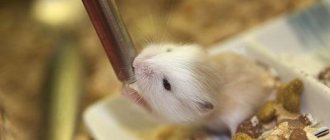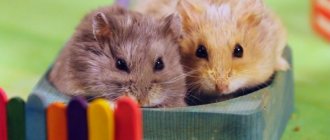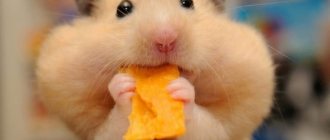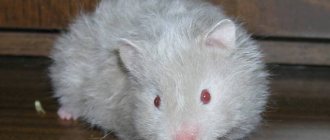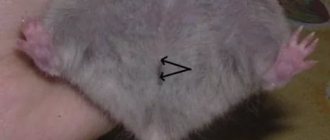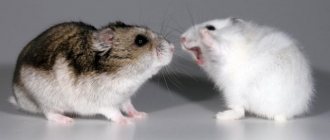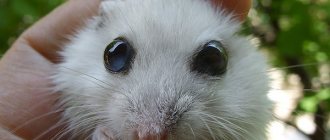When purchasing a rodent as a pet, many people wonder whether hamsters drink water. After all, it depends on whether you need to buy a drinking bowl. Opinions on the Internet on this matter differ - some believe that these animals receive enough fluid from succulent food (fruits, vegetables, berries). Others argue that water is essential for a hamster.
Does a hamster need drinking water?
There is an opinion that hamsters are content with the liquid contained in vegetables and fruits. Some people conclude that a hamster does not need water at all. For what? Hamsters, as you know, live in the desert and make do with the water contained in their food. And the fact that dew falls every night in the desert and persists until sunrise is completely ignored by such advisers, just as the fact that there is no dew in a cage. So the animal needs to be given water, in addition to food, and you should not give the hamster super-properties; this warm-blooded land animal needs to drink.
Therefore, hamsters drink water; they must be provided with a fresh supply on an ongoing basis. You need to keep an eye on the drinking bowl, especially if water is given once every 2-3 days, or so that a situation does not arise when the drinking bowl malfunctions and leaks, and the animal begins to suffer.
Strictly speaking, it is better to give hamsters a drink every day, for example, after cleaning the cage - this way you can easily control the drinking bowl itself, and microbes that can cause inflammatory diseases in your pet will not begin to multiply directly in the water.
In nature
Both the Syrian hamster and the Djungarian come from arid regions - steppes and semi-deserts. The animals avoid open bodies of water, and during rare rains they take refuge in burrows. Usually a person does not understand what desert-dwelling hamsters drink. The source of moisture for tiny animals is dew that falls at night. They lick the drops from the blades of grass to their heart's content.
Water container and daily dosage
A hamster needs easily accessible water. For this, a special drinking bowl or bowl is used. Any container is sold in pet stores and is presented in an assortment. The option with a bowl is not the best; the animal can easily pollute its water by throwing pieces of bedding in there or even turning it over. Then the floor in the cage will get wet, and the homa himself will not be able to drink.
Since the choice of special drinkers is large, it is more convenient to choose the option with a dispenser.
The daily dose depends on the breed and size of the hamster. And also on the microclimate in the apartment - how hot and dry it is in the house. It is generally accepted that these rodents require 10 milliliters of water per 100 grams of weight. This is 2 teaspoons.
Bowl or sippy cup?
The daily drinking rate for a healthy rodent is 5-15 ml of water per 100 g of body weight . Using a bowl can cause constant tipping and puddles inside the cage. Litter, feces and food can also spoil the taste of the water if you use the bowl as a reservoir. The optimal solution for the animal is a water bottle.
A drinking bowl attached to the walls of the enclosure saves space and easily trains the animal to drink. When you press the valve or ball at the end of the spout, water drips into the rodent's oral cavity. Most animals determine the source of moisture themselves, but sometimes help is required. Just splash a drop of water on your pet's nose.
Important! To ensure uninterrupted access to liquid for the rodent, the water in the drinking bowl should be replaced daily, and in the summer, 2-3 times a day.
What kind of water can you give your hamster?
There are also discussions on this topic - whether you can drink from a tap or not, whether you need to freeze water and the like, which in itself is already surprising. A simple and reliable way is to drink clean water from a cooler or buy bottled water in a store. Half a liter bottle of water will last the animal for more than a month.
Questionable choice
Making a bad choice when deciding what water to give is choosing the tap option. Everyone knows that such water contains a lot of chlorine and other chemical compounds. This is easy to verify if you leave the water to settle. Within about a day, flakes and a suspension of settled contaminants will appear at the bottom of the vessel in which the water settles.
Sometimes there are recommendations to freeze tap water, and then defrost and drink this water. But such advice is similar to misconception, because if freezing kills microbes, then heavy chemical suspensions will not go away. And there are no microbes in tap water as such after chlorine.
Optimal choice
Therefore, the animal needs to be given clean water from a cooler or store. Another option is boiled water, and it is also allowed to stand for a day or longer. But considering how little water hamsters drink, it is still better to buy a bottle of regular purified water and add it to the drinking bowl. The water, of course, must be still.
Diseases: immune, inflammatory, enzyme disorder
A hamster that drinks a lot of water and also produces a lot of urine may be suffering from one of the following diseases: diabetes, kidney inflammation, or ketoacidosis.
Diabetes
The predisposition to this disease is genetic and is inherited. Signs indicating a metabolic disorder are as follows:
- the animal’s urine will acquire a specific smell, which contains acetone, and therefore may resemble the smell of glue or nail polish;
- Homa's behavior will also undergo a change, the animal will be either lethargic or overly active;
- Appetite and appearance may not match each other.
Eating more food and losing weight at the same time clearly indicates the development of the disease.
How to exclude or confirm hamster diabetes at home
For this procedure, you need to purchase special strips from the pharmacy that detect sugar in the urine.
Attention! These are not strips for a glucometer, but specifically for urine. They are sold in cylindrical cases about 10 cm in length. The cost of these indicators is about 200 rubles per package. Most of these strips are also marked to detect ketone bodies, that is, the presence of acetone in the body.
The strip should be immersed in the hamster’s urine for a few seconds and evaluate how the indicator has changed. Typically, the scale for ketones ranges from beige to dark pink, while for sugar there is a green scale. A normal value corresponds to a sugar value from 4 to 5.5 mmol/l; after eating, this value can be higher - up to 10-12. In this case, if there is no acetone, you need to check for sugar again after 2-3 hours, keeping the hamster without food.
Refining the analysis
For the purity of measurements, it is best to take an analysis from the animal after it has slept for a long time. Having noticed such a moment, the sleepy ham needs to be placed in a clean tray. When the animal wakes up, it immediately pees. In this case, the accuracy of the test strip readings is quite high, because the hamster had a “fasting” period, because he did not eat during sleep and the concentration of substances in the urine itself increased for the same reason.
Analysis results
- If sugar is detected without acetone, then your hamster has type 2 diabetes. This disease is controlled by a low-carbohydrate diet and sugar-burning medications. In this type of diabetes, insulin is retained in the body, and therefore ketone bodies are not detected.
- If sugar and acetone are detected, your hamster has type 1 diabetes. Here, a diet is also used and the issue of insulin compensation is resolved, since in type 1 diabetes, insulin production completely stops.
Despite the general word diabetes, the mechanisms of disease development are different, as is the therapeutic approach.
Dehydration: causes and symptoms
A hamster is very vulnerable to dehydration and will not survive more than a day or two on dry food alone. Here the question of whether hamsters need water is excluded. Dehydration can occur in several situations:
- Khoma worked hard in the wheel, and then he ran out of water;
- the animal is sick, its stomach is upset and there is diarrhea, then dehydration can occur, despite a full drinking bowl;
- the hamster escaped from the cage and wandered around the apartment, in which case he is also at risk of dehydration;
- the animal may get sick and stop drinking;
- your pet may have suffered heatstroke.
In any case, dehydration develops very quickly and can be fatal if the situation is not corrected.
Milk: good or bad?
Wanting to diversify the diet, many owners treat hamsters with milk. Experts say that pregnant and lactating females should be fed dairy products . During the period of gestation and feeding, the body gives off energy and requires renewal.
4-5 grams of dissolved milk powder should be given for the first three weeks after the birth of the cubs.
If the mother dies, newborn hamsters are hand-fed with infant formula. Also, support with milk is needed for individuals who have suffered from the disease .
It is recommended to give milk to healthy and active animals no more than once a week as a reward or treat:
- It is advisable to choose milk with a minimum percentage of fat content.
- Before serving, the dairy product must be boiled and cooled for better digestibility.
- Cream, kefir, butter and cottage cheese with a high percentage of fat should be completely excluded from the diet. Products with a high proportion of fat content aggravate stomach and liver diseases.
Article on the topic: Is it possible to give hamsters boiled and raw beets?
How to spot the symptoms of dehydration
Symptoms of dehydration are easy to notice if you look closely:
- the homa will have sunken eyes;
- dry mucous membranes;
- the animal will be weak and lethargic;
- there may be difficulty breathing.
And in addition to the listed signs, the skin will become loose. The skin test is the fastest way to determine dehydration. You need to pinch and slightly pull the skin on the hamster's neck. If the skin immediately returns to its previous position, then everything is fine. If the skin lingers even for a short time in a raised position, the animal is dehydrated.
Various goodies
Grocery stores offer a variety of treats for hamsters. But before purchasing such food, you should make sure that there is no salt, sugar, flavor enhancers or flavorings in their composition. Such additives are a slow poison for rodents. Therefore, it is better to give preference to the following foods:
- Nuts.
- Banana chips.
- Dried fruits and dried vegetables.
- Sunflower seeds.
Hamster rehydration
If your pet is slightly dehydrated because he ran out of his cage for a few hours, you need to take care of the problem by refilling the water bottle so that he drinks as much as he wants.
You should not try to bathe your pet thinking that this will quickly restore it. Hamsters do not swim in nature. Bathing will be stressful for the animal, and it may catch a cold.
When you suspect your pet is severely dehydrated or you don't know how long he's been without water, it's best to contact your veterinarian. Indeed, in some diseases, especially with diarrhea, it is not the disease itself that quickly kills, but possible dehydration.
The veterinarian will administer a saline solution with salt and mineral supplements intravenously or subcutaneously to help restore the condition.
Why does a rodent drink a lot of liquid?
If your pet's need for water has sharply increased, and the hamster begins to drink a lot of liquid, then you need to think about a change in behavior.
- Changes in temperature and humidity in the room. The ideal temperature is considered to be up to +22 degrees. For favorable wakefulness, it is better to move the cage with the animal to a cool place.
- Damage to the drinking bowl. It is necessary to check the connections for integrity and replace them in case of leaks.
- Changing the diet or quickly introducing a new food. It is advisable to switch to a new type of food gradually. Adding salty foods can also be a source of thirst.
If there are no changes in the activity of the rodent, then the appearance of kidney disease and the development of diabetes are possible . The main signs are:
- Eating more food.
- Rapid weight loss or obesity.
- The ruffled pose of the animal.
- Irritability and increased activity.
- Increased sleep duration.
- Frequent urine discharge, possibly with the smell of nail polish.
When your hamster drinks the weekly amount of water, you must show the animal to a doctor and begin a course of treatment.
Article on the topic: Is it possible to give a hamster cookies, how to make them yourself
Vitamins for pets
Store-bought mixtures for hamsters contain all the necessary vitamins and microelements. However, in some cases it is necessary to introduce them artificially in order to protect pets from the development of infectious or viral diseases.
Vitamin complexes with different compositions are available for sale. However, you cannot choose them yourself without first consulting a veterinarian. The specialist will advise the appropriate complementary foods and dosage based on the age and condition of the pet’s body.
